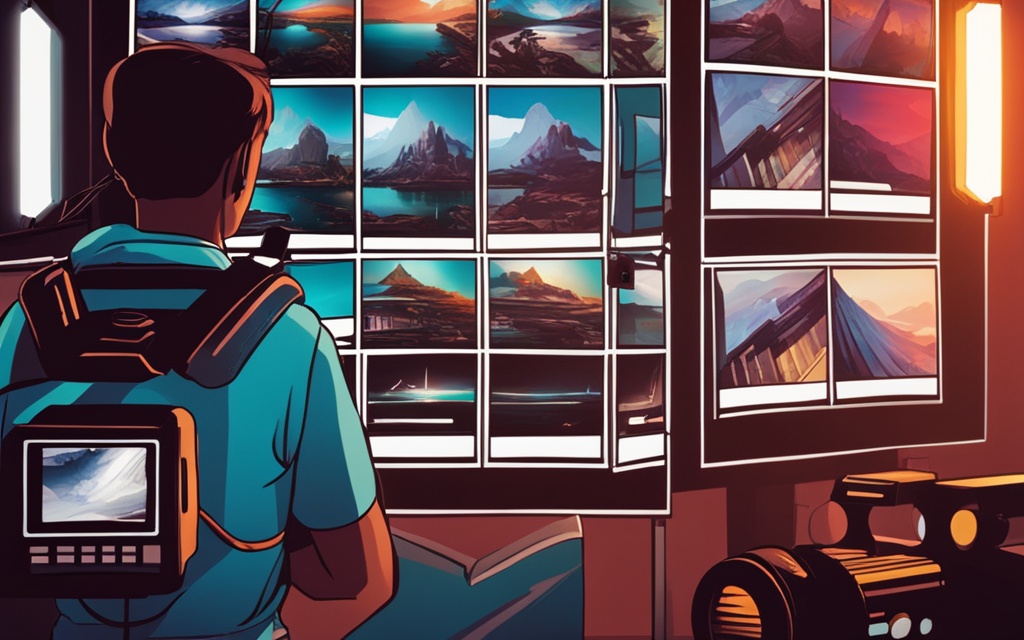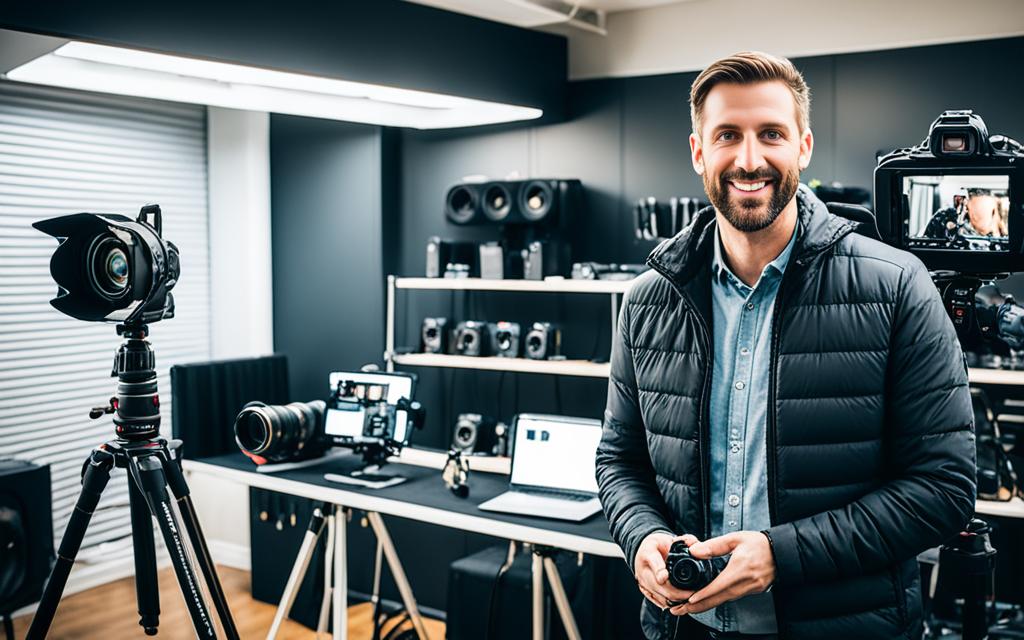In the world of video content creation, storytelling is key. And one essential tool that can take your storytelling to the next level is storyboarding. Whether you are creating a short video ad or a feature film, storyboarding plays a crucial role in planning and visualizing your ideas.
Storyboarding in video content creation involves creating a series of illustrated panels or frames that outline the sequence of shots, camera angles, and visual elements to be included in the final video. It provides a visual blueprint for your project, allowing you to organize your thoughts and communicate your vision effectively.
So why is storyboarding so important? Well, it offers several benefits that can significantly impact the success of your video content creation process. From improving the efficiency of your production to enhancing the overall storytelling experience, storyboarding can be a game-changer.
In this article, we will explore the role of storyboarding in video content creation and delve into its benefits. We will also provide practical tips on how to create a storyboard and highlight popular storyboarding tools and software. Additionally, we will showcase examples of effective storyboards and offer valuable insights to help you improve your own storyboarding skills.
Whether you are a professional filmmaker, content creator, or aspiring videographer, this article will equip you with the knowledge and tools necessary to harness the power of storyboarding in your video content creation journey.
Benefits of Storyboarding
Storyboarding plays a crucial role in the video content creation process, providing numerous benefits that can greatly enhance the quality and effectiveness of your videos. By incorporating storyboarding into your workflow, you can:
- Improve Communication: Storyboards serve as a visual representation of your creative vision, allowing you to effectively communicate your ideas to the entire production team. This ensures that everyone is on the same page and working towards a common goal.
- Streamline Production: By outlining the sequence of scenes and shots in advance, storyboarding helps you plan and organize your shoot more efficiently. This leads to smoother production processes, saving time and resources.
- Enhance Creativity: Storyboarding acts as a canvas for exploring and refining your creative concepts. It allows you to experiment with different visual elements, compositions, and narratives, enabling you to bring your vision to life in a more impactful way.
In addition, storyboarding in video content creation facilitates collaboration between directors, cinematographers, and other key stakeholders. It provides a framework for discussing and iterating on ideas, ensuring that the final result meets the desired objectives.
By utilizing storyboarding techniques, you can optimize your video production process, resulting in compelling and engaging content that resonates with your audience. The benefits of storyboarding extend beyond the planning stage, as it enables you to maintain a clear vision throughout each phase of the production process.
“Storyboarding allows us to visualize the story before filming, making it easier to plan shots and transitions. It helps us create a coherent and visually appealing narrative.” – Sarah Thompson, Director of Photography
Whether you’re creating a short promotional video or a feature-length film, incorporating storyboarding into your video content creation process is essential for achieving your desired results. The next section will delve into the step-by-step process of creating a storyboard.
How to Create a Storyboard
Storyboarding is a crucial step in the process of video content creation. It allows you to visualize your ideas, plan your shots, and ensure a smooth production. Here are the steps to effectively create a storyboard:
Gather your Materials
Start by gathering the necessary materials for your storyboard. You will need paper or a storyboard template, pencils or markers, and any reference materials such as scripts or shot lists.
Define Your Narrative
Begin by defining the narrative of your video. Determine the key moments, scenes, or actions that need to be visually represented in your storyboard. This will help you structure your story and ensure coherence.
Sketch your Frames
Next, start sketching your frames. Each frame represents a specific shot or scene in your video. Use simple, clear drawings to depict the composition, camera angles, and character movements. Don’t worry about making your sketches perfect; they are meant to capture the essence of the scene.
Add Descriptions and Dialogue
Under each frame, add descriptions and dialogue that provide additional context for your visuals. This could include details about camera movements, character actions, or specific lines of dialogue. These annotations will help guide the production team and ensure everyone is on the same page.
Arrange the Frames in Sequence
Once you have sketched all the necessary frames, arrange them in sequence. This will give you a visual representation of how the story unfolds. Pay attention to the flow and pacing of your frames to ensure a cohesive storytelling experience.
Review and Refine
Take the time to review and refine your storyboard. Look for any inconsistencies or areas that need improvement. Make adjustments as needed to enhance the clarity and impact of your visuals.
Share and Collaborate
Share your storyboard with your team or collaborators. Gather feedback and incorporate any relevant suggestions. Collaborating on a storyboard can lead to valuable insights and improvements for your video.
By following these steps, you can create a well-structured and visually engaging storyboard that will serve as a guide throughout the video production process. Remember, a strong storyboard sets the foundation for a successful video.
Storyboarding Tools and Software
When it comes to creating effective storyboards, having the right tools and software can greatly enhance the process. Whether you prefer a traditional approach or want to take advantage of modern digital solutions, there are various options available to suit your needs.
Traditional Tools
If you enjoy the tactile experience of sketching by hand, traditional storyboarding tools might be the perfect choice for you. Here are a few essentials:
- Pencil and Paper: The classic combination that allows you to sketch out your ideas quickly and easily.
- Storyboard Templates: Pre-printed sheets with predefined frames, making it convenient to draw your illustrations within the designated areas.
- Markers or Pens: Use different colors to bring your storyboards to life and add visual cues.
- Sticky Notes: Ideal for rearranging and organizing scenes, making it easy to experiment with different sequences.
Digital Tools and Software
For those who prefer a more digital approach, there are numerous software options available that offer advanced features and flexibility. Some popular choices include:
- Adobe Creative Cloud: The industry-standard suite of creative software, including Adobe Illustrator and Adobe Photoshop, offers powerful tools for creating detailed digital storyboards.
- Storyboarder: An open-source software designed specifically for storyboarding, offering an intuitive interface and features like automatic shot estimation.
- Toon Boom: A comprehensive animation software that allows you to create storyboards, animate characters, and bring your ideas to life.
Regardless of the tools or software you choose, the key is to find a solution that best aligns with your workflow and allows you to visualize your ideas effectively.
| Tool/Software | Features |
|---|---|
| Traditional Tools | Offers a hands-on approach with the freedom to sketch and rearrange scenes easily. |
| Adobe Creative Cloud | A comprehensive suite of software that provides advanced features for digital storyboarding and editing. |
| Storyboarder | A user-friendly and open-source software specifically designed for storyboarding. |
| Toon Boom | An animation software that allows for the creation of detailed storyboards and character animations. |
Examples of Effective Storyboards
Now that you understand the benefits and process of storyboarding in video content creation, let’s dive into some real-life examples of successful storyboards. By analyzing these examples, you can gain valuable insights into the best practices, composition techniques, and storytelling elements that make a storyboard impactful. Whether you’re a beginner or an experienced video creator, these examples will inspire and guide you in creating your own effective storyboards.
1. “The Adventure Begins”
This storyboard, created for a fantasy animation project, effectively captures the essence of the story. Each frame provides a clear visual representation of the key scenes, with attention to detail and composition. The use of color and shading helps set the mood, while annotations and descriptions guide the animators in bringing the storyboard to life.
2. “Cooking Show Promo”
This storyboard was developed for a cooking show promo. The frames showcase the step-by-step process of preparing a mouth-watering dish, accompanied by engaging annotations. The use of close-up shots and dynamic angles adds visual interest and creates a sense of excitement. The clear sequence of events ensures a smooth transition from one scene to another, effectively conveying the concept of the promo.
3. “Product Demonstration”
This storyboard was designed for a product demonstration video. Each frame highlights a specific feature of the product, supported by concise and descriptive annotations. The use of arrows and callouts directs the viewer’s attention to important details. The clear and logical flow of the frames ensures that the message is communicated effectively, making it an ideal tool for presenting the product’s benefits.
These examples demonstrate the power of effective storyboarding in video content creation. By carefully planning and visualizing your ideas, you can create compelling and engaging videos that resonate with your audience. Remember, the key to a successful storyboard lies in its ability to effectively communicate your vision and guide your team throughout the production process.
Tips for Improving Your Storyboards
Creating effective storyboards is a crucial step in the video content creation process. A well-executed storyboard not only helps you visualize your ideas but also serves as a guide for the entire production team. Here are some valuable tips to enhance the quality of your storyboards and elevate your storytelling skills:
- Focus on clarity and simplicity: Keep your visuals and annotations clear and easy to understand. Use simple sketches and concise descriptions to convey your ideas.
- Plan your shots: Consider the camera angles, movements, and transitions you plan to use in your video. This will help you create a more dynamic and engaging visual narrative.
- Pay attention to composition: Think about the visual composition of each frame. Consider elements such as framing, symmetry, and the rule of thirds to create visually pleasing and balanced shots.
- Develop character expressions and poses: Focus on capturing the emotions and actions of your characters. Experiment with different facial expressions and body postures to bring your characters to life.
- Use color and lighting effectively: Experiment with different color schemes and lighting techniques to set the mood and enhance the storytelling. Consider the use of shadows, highlights, and color symbolism.
- Incorporate feedback: Seek feedback from your team or clients to improve your storyboards. Be open to constructive criticism and make necessary revisions to create a stronger visual narrative.
Remember, storyboarding is an iterative process. Don’t be afraid to make changes and refine your ideas as you progress. It’s okay to experiment and explore different approaches to find what works best for your project.
By following these tips, you can elevate the quality of your storyboards and create compelling visuals that effectively communicate your message. Take your time during the storyboarding phase, as it lays the foundation for a successful video production.
Next, we will explore some valuable storyboarding tools and software that can streamline your workflow and enhance your storyboard creation process.
Conclusion
Incorporating feedback in storyboarding is a crucial aspect of video content creation. Storyboarding allows you to visually plan and organize your ideas, ensuring a smooth production process and delivering compelling visual narratives. By using storyboards, you can effectively communicate your vision to your team, stakeholders, and clients, resulting in a cohesive and engaging final product.
Storyboarding in video content creation provides numerous benefits, such as improved communication, enhanced creativity, and efficient resource allocation. It allows you to identify potential challenges, make necessary revisions, and iterate on ideas before production begins. With storyboarding tools and software, you can streamline the storyboarding process, saving time and effort while maintaining clarity and precision in your visual storytelling.
Remember, a well-crafted storyboard serves as a blueprint for your video project. By following the tips shared in this article and continually improving your storyboards, you can create visually captivating videos that resonate with your target audience. Incorporate feedback from your team and stakeholders to refine your concept and enhance the overall quality of your video content. Embrace the power of storyboarding and unleash your creativity in the realm of video production.






